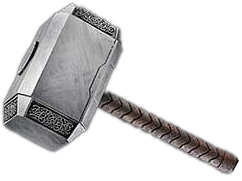Definition2.3.1Product of chain complexes
If \(A,B\) are chain complexes the \(C=A \otimes B\) is the chain complex with
\[C_i = \bigoplus_{j+k = i}A_j \otimes B_k\]
and
\[d(a\otimes b) = (da)\otimes b + (-1)^{|a|} a\otimes (db)\]
where \(|a| = j\) if \(a \in A_j\).
The following theorem is true but we will not prove it.
Theorem2.3.2Eilenberg-Zilber
\[C_*(X\times Y) \sim C_*(X) \otimes C_*(Y).\]Given \(H_*(A)\) and \(H_*(B)\) how can we compute \(H_*(A\otimes B)\).
Lemma2.3.3
Suppose \(A\sim A'\). Then \(A\otimes B \sim A'\otimes B\).Proof
Corollary2.3.4
Suppose \(A,B\) are finitely generated chain complexes, defined over a field. Then
\[H_*(A\otimes B) = \bigoplus_{j+k = i} H_j(A) \otimes H_k(B)\]
i.e.
\[H_*(A\otimes B) \cong H_*(A) \otimes H_*(B).\]Proof
\(A\) is a chain complex over a field, so \(A\sim A'\) where \(A'_i = H_i(A)\) and \(d \equiv 0\) on \(A'\).
Similarly for \(B\).
Then
\[H_*(A\otimes B) \cong H_*(A'\otimes B') \cong A'\otimes B' = H_*(A)\otimes H_*(B).\]
Corollary2.3.5
If \(k\) is a field and \(X,\,Y\) are finite chain complexes then
\[H_*(X\times Y; k)\cong H_*(X; k) \otimes_k H_*(Y; k).\]
Definition2.3.6Poincare polynomial
The Poincare polynomial of \(X\) with coefficients in \(k\) is
\[P_k(X) = \sum_{i\ge 0} \dim H_i(X; k) t^i.\]
Example2.3.7
\[P_{\ZZ/2} (\RP^2) = 1 + t + t^2.\]2.3.5 tells us that \[P_k(X\times Y) = P_k(X)P_k(Y).\]
Example2.3.8
\[P_{\ZZ/2}(\RP^3 \times \RP^2) = (1+t+t^2)(1+t+t^2+t^3).\]For now we will suppose that \(A,B\) are finitely generated chain complexes over a PID \(R\).
Lemma2.3.9
If \(H_*(A)\) is a free \(R\)-module then \(A\sim A'\) where \(A_i' = H_i(A)\) and \(d\equiv 0\) on \(A'\).
Proof
\(A\) is the direct sum of short and stupid complexes. \(H_*(A)\) being torsion free implies that every short complex is of the form
\[
\xymatrix{ C\colon R\ar@<.5ex>[r]^{\cdot a} & R \ar@<.5ex>[l]^{\cdot a^{-1}}}
\]
with \(a\in R^\times\) such a \(C \sim 0\) (same proof as for a field).
Corollary2.3.10
If \(H_*(A)\) is free then \(H_*(A\otimes B) \cong H_*(A) \otimes H_*(B)\).Proof
\(A\otimes B \cong A' \otimes B\) where \(A'\) is as in 2.3.9.
\(A'\otimes B\) is a direct sum of copies of \(B\), one for each generator of \(A'\).
This gives that \(H_*(A'\otimes B)\) is a direct sum of copies of \(H_*(B)\), one for each generator of \(H_*(A)\) which implies that
\[H_*(A\otimes B) \cong H_*(A) \otimes H_*(B)\]
(since \(H_*(A)\) is free).
\[R^n \otimes H_*(B) \cong (H_*(B))^n.\]
Corollary2.3.11
If \(X\) and \(Y\) are finite cell complexes and \(H_*(X)\) is free over \(\ZZ\), then \(H_*(X\times Y) \cong H_*(X) \otimes H_*(Y)\).Fact: If \(C_1\) is a free resolution of \(M\) and \(C_2\) is a free resolution of \(N\).
Then
\[\Tor_i(M,N) \cong H_i(C_1 \otimes C_2) \cong H_i(C_1 \otimes N) \cong H_i(M\otimes C_2).\]
Theorem2.3.12Kunneth formula
If \(A,B\) are free (finitely generated) chain complexes over a PID \(R\) then
\[H_i(A\otimes B) \cong \bigoplus_{j + k = i} \Tor_0(H_j(A), H_k(B)) \oplus\bigoplus_{j+k = i-1} \Tor_1(H_j(A), H_k(B)).\]Proof
It suffices to check the statement where \(A,B\) are short and/or stupid.
We just did the case where both are short.
The case where one or more is stupid was covered in the statement that
\[H_*(A\otimes B) \cong H_*(A) \otimes H_*(B)\]
if \(H_*(A)\) is free.
Corollary2.3.13
We can compute \(H_*(X\times Y)\) from \(H_*(X)\) and \(H_*(Y)\).